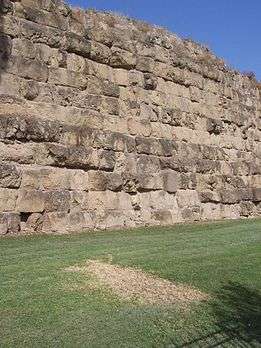Ancient Roman defensive walls

Defensive walls are a feature of ancient Roman architecture. The Romans generally fortified cities, rather than fortresses, but there are some fortified camps, such as the Saxon Shore forts like Porchester Castle in England. City walls were already significant in Etruscan architecture, and in the struggle for control of Italy under the early Republic many more were built, using different techniques. These included tightly-fitting massive irregular polygonal blocks, shaped to fit exactly in a way reminiscent of later Inca work. The Romans called a simple rampart wall an agger; at this date great height was not necessary. The Servian Wall around Rome was an ambitious project of the early 4th century BC. The wall was up to 10 metres (32.8 ft) in height in places, 3.6 metres (12 ft) wide at its base, 11 km (7 mi) long,[1] and is believed to have had 16 main gates, though many of these are mentioned only from writings, with no other known remains. Some of it had a fossa or ditch in front, and an agger behind, and it was enough to deter Hannibal. Later the Aurelian Wall replaced it, enclosing an expanded city, and using more sophisticated designs, with small forts at intervals.
The Romans walled major cities and towns in areas they saw as vulnerable, and parts of many walls remain incorporated in later defences, as at Córdoba (2nd century BC), Chester (earth and wood in the 70s AD, stone from c. 100), and York (from 70s AD). Strategic walls defending the frontiers of the Empire by running across open country were far rarer, and Hadrian's Wall (from 122) and the Antonine Wall (from 142, abandoned only 8 years after completion) are the most significant examples, both on the Pictish frontier. Most defences of the borders of the Roman Empire relied on systems of forts and roads without attempting a continuous barrier.
Significant examples
Notable walls built by ancient Rome include, in chronological order of construction:
- Servian Wall, built around Rome in the early 4th century BC
- Roman walls of Córdoba
- Chester city walls, originating as part of the fortress of Deva Victrix between 70 and 80 AD
- York city walls, originally constructed around 71 AD when York was a Roman colony
- Hadrian's Wall, built in England beginning in 122 AD at the edge of Roman conquest to keep out the Scots
- Antonine Wall, a short-lived, advanced frontier wall built in Scotland north of Hadrian's Wall beginning in 142 AD
- London Wall, built around Londinium between 190 and 225, probably between 200 and 220
- Roman walls of Lugo, built between 263 and 276 AD to defend the Roman town of Lucus Augusti (in what is now Spain)
- Aurelian Walls, the later wall of Rome, built in the late 3rd century AD
- Walls of Constantinople, a great defensive wall that defended the metropolitan capital from the fourth century AD until 1453
- Anastasian Wall, a wall named after Byzantine Emperor Anastasius I to ensure extra defenses for Constantinople; there is evidence that the fortification existed in 469, prior to his reign. Strictly Byzantine rather than Roman, it was not very effective, and abandoned in the 7th century.
See also
- Museum of the Walls, Rome
- Roman military frontiers and fortifications
- Limes, a border defense or delimiting system of ancient Rome
References
- ↑ Fields, Nic; Peter Dennis The Walls of Rome Osprey Publishing; 10 Mar 2008 ISBN 978-1-84603-198-4 p.10
Further reading
- Wilson, Barbara, Mee, Frances, The City Walls and Castles of York: The Pictorial Evidence, 2005, York Archaeological Trust, ISBN 978-1-874454-36-6